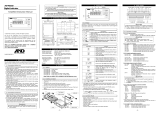
PROGRAMMING MODULE #4 - PROGRAM DIGITAL FILTER AND REMOTE INPUT
PROGRAM DIGITAL FILTERING
If the displayed process signal is difficult to read due to small process
variations or noise, increased levels of filtering will help to stabilize the display.
This programming step may be used in conjunction with display rounding
programming (Pro1&2)to help minimize this effect. The digital filter used is an
“adaptive” filter. That is, the filter coefficients change dynamically according to
the nature of the input signal. This feature simultaneously allows the filter to
settle quickly for large input changes while providing a stable display reading for
normal process variations. Because of the adaptive nature of the filter, it cannot
be characterized in terms of a time constant. The following table lists the
maximum settling time for a step input to within 99% of final value.
Filter Value Settling Time (99%)
“FILtEr” < > “0” - no digital filtering 1.5 sec.
“1” - normal filtering 2 sec.
“2” - increased filtering 6 sec.
“3” - maximum filtering 13 sec.
PROGRAM FUNCTION OF E1-CON AND OPTIONAL
E2-CON PIN
The function of the remote input “E1-CON” pin (TBA #4) and, if the totalizer
option is installed, the remote input “E2-CON” pin (TBA #7) are the same.
Functions are activated, as described in the appropriate function, when
connected to signal common (TBA #5). Whether a function is edge or level
activated it must be held low for a minimum of 20 msec in order for the function
to occur. The remote input pins can be used simultaneously and with any
combination of functions. When pins are tied together and activated, E1-CON
function is generally performed first.
“E1-CON” < > “0” - A negative going edge re-zeros (tares) the input signal.
Note: The tare buffer can be cleared by “stepping” through
“Pro 2”, using the P button.
“1” - A negative going edge resets the contents of the totalizer to
zero. Totalization commences regardless of the state of the
input.
“2” - A negative going edge resets the contents of the totalizer to
zero and allows totalization as long as the input is low. If the
input goes high, totalization is stopped and the contents are
saved. This acts as a totalization enable control from time T1 to
T2.
“3” - A low level allows totalization from the previously saved
contents as long as the input is low. If the input goes high,
totalization is stopped and the contents are saved. This acts as a
totalization enable control from time T1 to T2.
“4” - A low level holds the display (display hold). While this input is
low, the indicator continues to process the input signal and
drive the alarms, totalizer, etc. with the actual signal. The
contents of the totalizer are stored at the same time when the
input display is held.
Note: If display hold is activated, and input value was showing
in the display, the operator can switch to total value by pressing
the up button.
“5” - A negative going edge resets both peak and valley buffers.
Note: After P/V is called up, a change will not appear on the
display until the next time the P/V is called up.
“6” - A negative going edge resets only the peak buffer and the
indicator enters a peak reading display mode as long as the
input is low. If the input goes high, peak detection and
indication is stopped and the last peak reading is retained.
“7” - A negative going edge resets only the valley buffer and the
indicator enters a valley reading display mode as long as the
input is low. If the input goes high, valley detection and
indication are stopped and the last valley reading is retained.
“8” - If the alarm option is installed, a negative going edge resets the
latched alarm(s).
“9” - If the alarm option is installed, a low level resets a latched or
unlatched alarm into its inactive state. This provides manual
override of alarms for system start-up and other unusual events
such as system testing.
“10” - A negative going edge toggles the display between “input”
and “total” (from input to total, or vice versa). No action is
taken on the positive going edge.
-12-


























